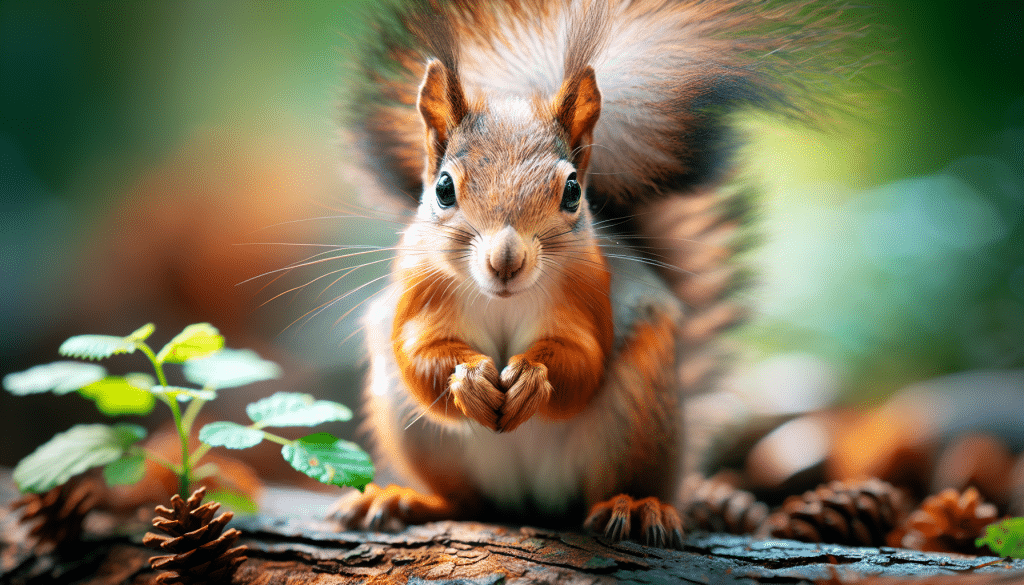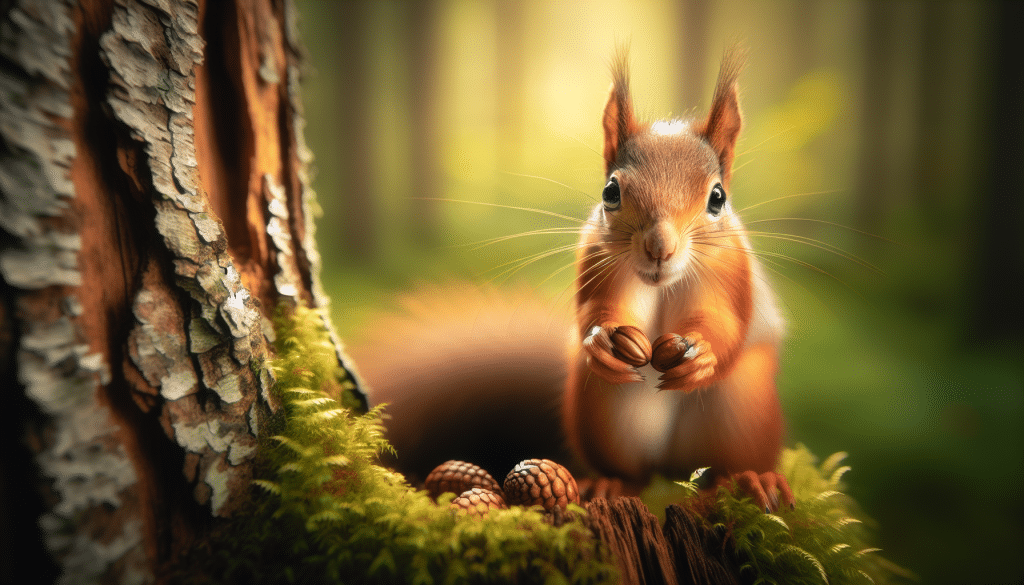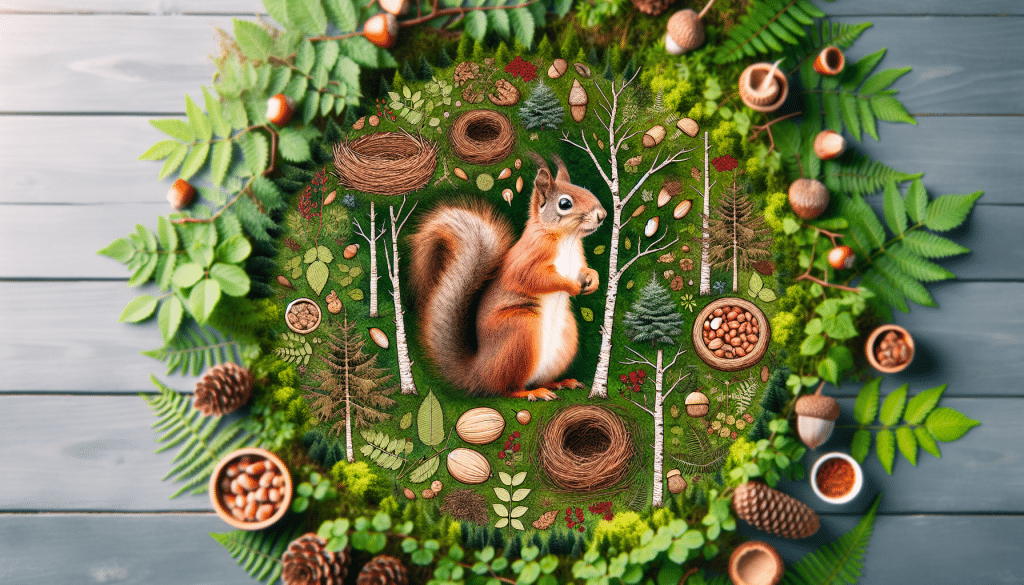In order to fully comprehend and appreciate the intricacies of squirrel behavior, it is essential to delve into the realm of squirrel training and behavior. By exploring the underlying reasons behind their actions and observing their interactions with their environment, we gain valuable insights into their unique characteristics and habits. With this understanding, we can foster a harmonious coexistence with these fascinating creatures and effectively address any challenges that may arise. So, let us embark on a journey of discovery, where we unravel the mysteries of squirrel behavior and unlock the secrets that lie within their furry world.

Understanding Squirrel Habitats
Squirrels, part of the rodent family, are known for their adaptability and versatility in various habitats around the world. Their habitats can be broadly categorized into two types: tree squirrel habitats and ground squirrel habitats.
Types of Habitats
Tree squirrels, as the name suggests, primarily inhabit forests and wooded areas where trees provide them with both shelter and food sources. The dense foliage of trees offers protection from predators, while the abundance of acorns, nuts, and seeds found in these habitats serves as a vital food source for these squirrels.
On the other hand, ground squirrels are commonly found in open grasslands, meadows, and prairies. They thrive in areas where the ground is suitable for burrowing, allowing them to create elaborate tunnel systems for shelter and protection. Ground squirrels feed on a variety of vegetation, seeds, and berries found in their habitat.
Tree Squirrel vs Ground Squirrel Habitats
While tree squirrels prefer arboreal habitats high up in trees, ground squirrels tend to dwell in underground burrows. This distinction in habitats plays a significant role in shaping their behaviors and survival strategies. Tree squirrels are excellent climbers and rely on their agility and tree-dwelling abilities to evade predators and access food sources. Ground squirrels, on the other hand, have adapted to their burrowing lifestyle, using their strong digging abilities to create complex systems of tunnels.
The Impact of Urban Environments on Squirrel Behavior
Urban environments have increasingly become the new home for many squirrel populations. As cities expand and encroach upon natural habitats, squirrels are forced to adjust their behavior to survive in these urban landscapes.
Urban environments present both challenges and opportunities for squirrels. The abundance of human-generated food sources such as garbage bins and bird feeders can be a boon for squirrels, providing them with readily available food. However, increased exposure to humans and domestic pets can also pose risks, such as predation and the transmission of diseases.
Despite these challenges, urban squirrels have shown remarkable adaptability. They have developed new foraging strategies, utilizing human-built structures like telephone poles and buildings to navigate their environment. Furthermore, these adaptable creatures have demonstrated the ability to thrive even in densely populated urban settings.

Social Structure and Dynamics
Squirrels exhibit complex social behaviors and hierarchies within their communities. Understanding these dynamics is crucial to gaining insight into how they interact and function within their habitats.
Territorial Behavior
Squirrels, both tree and ground-dwelling, are territorial creatures. They mark their territory using scent glands located on various parts of their body. By doing so, they communicate boundaries and minimize conflicts with neighboring squirrels. Scent marking allows squirrels to distinguish between familiar and unfamiliar individuals, thereby maintaining territorial coherence.
Hierarchy and Social Order
Within squirrel communities, there exists a hierarchical structure, with dominant individuals asserting control over resources and mate selection. Dominance is established through displays of aggression and physical encounters. Subordinate squirrels usually defer to dominant individuals and may be excluded from accessing food sources or mating opportunities.
Interaction between Different Squirrel Species
Different species of squirrels often coexist in the same environment, leading to complex interactions. In some cases, inter-species competition for resources can arise, leading to territorial disputes and aggressive encounters. However, certain species are known to form symbiotic relationships, where their behaviors complement each other to enhance survival and resource utilization.
Foraging Habits and Food Preferences
Squirrels are opportunistic foragers, making use of a wide range of food sources available in their habitats. Understanding their foraging habits and preferences sheds light on their ecological role as seed dispersers and their impact on plant communities.
Common Foods in a Squirrel’s Diet
Squirrels have a diverse diet that includes nuts, acorns, seeds, berries, fruits, flowers, and even fungi. Their preferences may vary based on the availability of different food sources throughout the seasons. For example, during the fall, tree squirrels focus on gathering and storing nuts, while ground squirrels may feed on grasses and herbaceous plants.
Seasonal Foraging Patterns
Squirrels are known for their remarkable ability to cache food for future consumption. During times of abundance, they hoard food and store it in various locations within their territory. These stored food caches help sustain them during periods of food scarcity, such as winter.
Adaptive Foraging Strategies in Urban Areas
Urban environments present both opportunities and challenges for squirrel foraging. While human-generated food sources are readily available, they may not provide the same nutritional value as natural food sources. Squirrels have been observed adapting their foraging strategies to make use of these urban food resources, such as raiding bird feeders or scavenging in trash bins. This adaptability highlights their ability to thrive in human-altered landscapes.

Reproduction and Mating Behaviors
Understanding squirrel reproduction and mating behaviors is essential for comprehending population dynamics and the survival of these charismatic creatures.
Mating Season Variations
The mating season for squirrels varies depending on the species and geographic location. Generally, squirrels have distinct breeding seasons during the spring and summer months when environmental conditions are favorable for survival and the availability of food resources is abundant.
Nesting Behaviors
Squirrels construct nests, called dreys, for shelter and raising their young. Tree squirrels typically build dreys using leaves, twigs, and other natural materials, while ground squirrels create underground burrows for nesting. Nests are strategically located to provide protection from predators and adverse weather conditions.
Parental Care and Juvenile Development
Squirrels exhibit remarkable parental care, with females taking the primary responsibility for raising their young. The mother squirrel provides warmth, protection, and nourishment to her offspring until they are independent enough to forage and fend for themselves. Parental care plays a crucial role in the survival and development of young squirrels.
Communication Methods Among Squirrels
Squirrels utilize various communication methods to convey messages within their community, ensuring the coordination of behaviors and maintaining social cohesion.
Vocalizations and Their Meanings
Squirrels use a variety of vocalizations, such as chirps, chatters, and barks, to communicate different messages. These vocalizations can signal alarm, warn of potential threats, or indicate the presence of predators. Each vocalization has a specific meaning and context within their social interactions.
Tail Signals and Body Language
Squirrels employ their bushy tails and body movements to communicate their intentions and emotions to other squirrels. A twitching or fluffed-up tail can act as a warning signal, signaling danger or territorial claims. Additionally, squirrels use body postures and facial expressions to convey dominance or submission during social interactions.
Scent Marking and Territory Defense
Squirrels possess scent glands in various parts of their bodies, allowing them to mark their territories. These scent markings serve as a form of communication, indicating ownership and territorial boundaries to other squirrels. By detecting these scent markers, squirrels can avoid territorial disputes and minimize conflicts.
Seasonal Adaptations and Activities
Squirrels exhibit behavioral changes and adaptations in response to seasonal variations, ensuring their survival and successful reproduction.
Behavioral Changes with Seasons
Squirrels exhibit distinct behavioral changes as the seasons shift. During the fall, squirrels prioritize hoarding and storing food to prepare for the coming winter. In winter, their activity levels decrease as they conserve energy and rely on stored caches. With the arrival of spring, squirrels increase their foraging and mating activities to take advantage of the abundant food resources and favorable environmental conditions.
Hibernation vs. Active Winter Survival
While some species of squirrels hibernate during the winter months, others remain active and rely on their stored food caches. Ground squirrels are known for their ability to hibernate, lowering their metabolic rate and conserving energy. Tree squirrels, on the other hand, actively forage and rely on cached food to survive the winter.
Preparation for Changes in Food Availability
As the seasons change, squirrels engage in behaviors that allow them to adapt to the varying availability of food. They meticulously gather and store nuts, acorns, and seeds during periods of abundance, ensuring a secure food supply when resources become scarce. This behavioral adaptation helps them survive during times of food constraints, such as winter months.
Squirrels and Human Interaction
Squirrels often share living spaces with humans, leading to various interactions and conflicts. Understanding these interactions is essential to achieve harmonious coexistence and minimize negative impacts.
Feeding and Human Encouragement of Habituation
Human activities, such as intentionally feeding squirrels, can lead to habituation. Squirrels become accustomed to human presence and reliance on handouts, which can disrupt their natural foraging behaviors and potentially lead to nutritional imbalances. Encouraging natural foraging behaviors, rather than artificial feeding, is crucial in maintaining the health and well-being of squirrel populations.
Common Conflicts and Resolution Strategies
Conflicts between squirrels and humans usually revolve around property damage, such as chewed electrical wires or raided bird feeders. Employing squirrel-proofing measures, such as modifying bird feeders or securing entry points to homes, can help mitigate these conflicts. Educating the public on the importance of coexistence and the impact of human activities on squirrel behavior is instrumental in reducing conflicts.
The Role of Squirrels in Urban Ecosystems
Despite the challenges associated with urban environments, squirrels play a vital role in urban ecosystems. They act as seed dispersers, helping to maintain healthy plant populations by burying and forgetting their cached food. Squirrels also serve as prey for various predators, contributing to the ecological balance within urban areas.
The Intelligence of Squirrels
Squirrels have garnered attention for their remarkable problem-solving skills, adaptability, and use of tools in specific situations.
Problem-Solving Skills
Squirrels have demonstrated remarkable problem-solving abilities when it comes to accessing food sources. From solving complex puzzles to outsmarting squirrel-proof bird feeders, their ingenuity and resourcefulness are awe-inspiring.
Ability to Adapt and Learn
Squirrels exhibit a high degree of adaptability to changing environments. They quickly learn to navigate novel structures and adapt their foraging strategies to maximize resource acquisition. This adaptability showcases their ability to thrive even in the face of new challenges.
Observations of Tool Use
In certain situations, squirrels have been observed using tools to aid in their foraging activities. For example, they have been observed using sticks to dislodge hard-to-reach nuts or using rocks to break open shells. This observation highlights their ability to engage in problem-solving behaviors and utilize available resources to their advantage.
Training and Behavioral Conditioning
Squirrels can be trained and conditioned to exhibit certain behaviors through positive reinforcement and rewards.
Effective Methods for Squirrel Training
Training squirrels usually involves positive reinforcement techniques, such as offering food rewards or praise when they display desired behaviors. Consistency, patience, and repetition are key factors in successful training.
Rewards and Positive Reinforcement
When training squirrels, rewards play a crucial role in reinforcing desired behaviors. Offering food rewards or other incentives encourages squirrels to repeat the behavior and associate it with a positive outcome.
Challenges in Training Squirrels
Squirrels, being highly independent and quick, can present challenges in training. Their natural instincts and skittish nature may make it difficult to maintain their attention and focus during training sessions. Establishing trust, using high-value rewards, and gradually increasing training difficulty can help overcome these challenges.
The Impact of Climate Change on Squirrel Behavior
As climate change continues to alter ecosystems worldwide, it has the potential to influence squirrel behavior in various ways.
Changes in Foraging and Food Storage
With alterations in temperature and precipitation patterns, changes in plant communities and food availability are likely to occur. This can impact squirrel foraging behaviors and alter their food storage strategies. Squirrels may need to adapt to shifts in vegetation patterns and adjust their caching and food hoarding behaviors accordingly.
Reproductive Patterns and the Influence of Weather
Climate change can affect the timing and success of squirrel reproduction. Shifts in environmental cues, such as temperature and photoperiod, may disrupt the synchronization of mating behaviors and impact the survival of offspring. Changes in weather patterns may also influence survival rates during critical stages of juvenile development.
Adaptation to Altered Habitats
As climate change reshapes habitats, squirrels may experience range shifts and habitat fragmentation. Some species may need to adapt to new environmental conditions or disperse to find suitable habitats. The ability to adapt to these altered habitats will be crucial for the long-term survival of squirrel populations.
In conclusion, understanding squirrel behavior is a key aspect of appreciating their ecological significance and promoting their conservation. From their habitat preferences and social interactions to their foraging habits and reproductive strategies, squirrels exhibit diverse and fascinating behaviors. By studying and respecting these behaviors, we can contribute to the preservation of these charismatic and adaptable creatures in both natural and urban environments.


